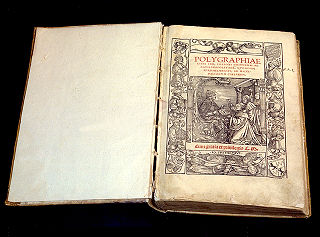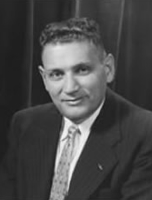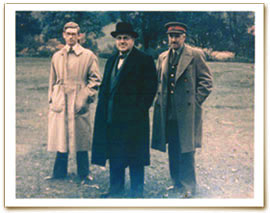
Cryptanalysis refers to the process of analyzing information systems in order to understand hidden aspects of the systems. Cryptanalysis is used to breach cryptographic security systems and gain access to the contents of encrypted messages, even if the cryptographic key is unknown.

In the history of cryptography, the "System 97 Typewriter for European Characters" (九七式欧文印字機) or "Type B Cipher Machine", codenamed Purple by the United States, was an encryption machine used by the Japanese Foreign Office from February 1939 to the end of World War II. The machine was an electromechanical device that used stepping-switches to encrypt the most sensitive diplomatic traffic. All messages were written in the 26-letter English alphabet, which was commonly used for telegraphy. Any Japanese text had to be transliterated or coded. The 26-letters were separated using a plug board into two groups, of six and twenty letters respectively. The letters in the sixes group were scrambled using a 6 × 25 substitution table, while letters in the twenties group were more thoroughly scrambled using three successive 20 × 25 substitution tables.

William Frederick Friedman was a US Army cryptographer who ran the research division of the Army's Signal Intelligence Service (SIS) in the 1930s, and parts of its follow-on services into the 1950s. In 1940, subordinates of his led by Frank Rowlett broke Japan's PURPLE cipher, thus disclosing Japanese diplomatic secrets before America's entrance into World War II.

Books on cryptography have been published sporadically and with highly variable quality for a long time. This is despite the tempting, though superficial, paradox that secrecy is of the essence in sending confidential messages — see Kerckhoffs' principle.

Elizebeth Smith Friedman was an American expert cryptanalyst and author who deciphered enemy codes in both World Wars and helped solve international smuggling cases during Prohibition. Over the course of her career, she worked for the United States Treasury, Coast Guard, Navy and Army, plus the International Monetary Fund. She has been called "America's first female cryptanalyst".

Solomon Kullback was an American cryptanalyst and mathematician, who was one of the first three employees hired by William F. Friedman at the US Army's Signal Intelligence Service (SIS) in the 1930s, along with Frank Rowlett and Abraham Sinkov. He went on to a long and distinguished career at SIS and its eventual successor, the National Security Agency (NSA). Kullback was the Chief Scientist at the NSA until his retirement in 1962, whereupon he took a position at the George Washington University.
Cryptography, the use of codes and ciphers to protect secrets, began thousands of years ago. Until recent decades, it has been the story of what might be called classical cryptography — that is, of methods of encryption that use pen and paper, or perhaps simple mechanical aids. In the early 20th century, the invention of complex mechanical and electromechanical machines, such as the Enigma rotor machine, provided more sophisticated and efficient means of encryption; and the subsequent introduction of electronics and computing has allowed elaborate schemes of still greater complexity, most of which are entirely unsuited to pen and paper.

Brigadier John Hessell Tiltman, was a British Army officer who worked in intelligence, often at or with the Government Code and Cypher School (GC&CS) starting in the 1920s. His intelligence work was largely connected with cryptography, and he showed exceptional skill at cryptanalysis. His work in association with Bill Tutte on the cryptanalysis of the Lorenz cipher, the German teleprinter cipher, called "Tunny" at Bletchley Park, led to breakthroughs in attack methods on the code, without a computer. It was to exploit those methods, at extremely high speed with great reliability, that Colossus, the first digital programmable electronic computer, was designed and built.
The Signal Intelligence Service (SIS) was the United States Army codebreaking division through World War II. It was founded in 1930 to compile codes for the Army. It was renamed the Signal Security Agency in 1943, and in September 1945, became the Army Security Agency. For most of the war it was headquartered at Arlington Hall, on Arlington Boulevard in Arlington, Virginia, across the Potomac River from Washington (D.C.). During World War II, it became known as the Army Security Agency, and its resources were reassigned to the newly established National Security Agency (NSA).
The Two-square cipher, also called double Playfair, is a manual symmetric encryption technique. It was developed to ease the cumbersome nature of the large encryption/decryption matrix used in the four-square cipher while still being slightly stronger than the single-square Playfair cipher.
The Dundee Society was a society of graduates of CA-400, a National Security Agency course in cryptology devised by Lambros D. Callimahos, which included the Zendian Problem. The class was held once a year, and new members were inducted into the Society upon completion of the class. The Society was founded in the mid-1950s and continued on after Callimahos' retirement from NSA in 1976. The last CA-400 class was held at NSA in 1979, formally closing the society's membership rolls.
The Zendian problem was an exercise in communication intelligence operations devised by Lambros D. Callimahos as part of an advanced course, CA-400, that Callimahos taught to National Security Agency cryptanalysts starting in the 1950s.
Codes and ciphers were used extensively in World War I. The decoding by British Naval intelligence of the Zimmermann telegram helped bring the United States into the war.
The Cipher Department of the High Command of the Wehrmacht was the Signal Intelligence Agency of the Supreme Command of the Armed Forces of the German Armed Forces before and during World War II. OKW/Chi, within the formal order of battle hierarchy OKW/WFsT/Ag WNV/Chi, dealt with the cryptanalysis and deciphering of enemy and neutral states' message traffic and security control of its own key processes and machinery, such as the rotor cipher machine ENIGMA machine. It was the successor to the former Chi bureau of the Reichswehr Ministry.
The Pers Z S was the Signal Intelligence Agency of the German Foreign Office before and during World War II. It consisted of two cryptologic sections. Pers Z S was the cryptanalytic section which was called Special Service of Z Branch of the Foreign Office Personnel Department. Its mission was the solution of foreign diplomatic codes and ciphers. The other section, which was the Cryptography Section was called Personal Z Cipher Service of the Federal Foreign Office. The latter section was responsible for compilation, distribution and security of Foreign Office codes and ciphers. Both were colloquially known as Pers Z S. Though similar in nature and operation to the OKW/Chi cipher bureau, it was a civilian operation as opposed to the military operation at OKW/Chi and focused primarily on diplomatic communications. According to TICOM interrogators it evinced an extraordinary degree of competence, primarily driven by a consistency of development not found in any other German signals bureau of the period. Pers Z S/Chi was the symbol and the code name of the Chiffrierdienst, i.e. the Cryptanalysis Department of Pers Z S. Although little is known about the organization, in the final analysis, Pers Z S labored at diplomatic cryptanalysis for a regime for which there were no diplomatic solutions.
Peter Novopashenny was before and during the World War I, a Russian Marine Officer and who worked as a cryptanalyst during World War II for the German Wehrmacht (OKW/Chi) cipher bureau, working on the Russian desk, deciphering enciphered Soviet communications.
General der Nachrichtenaufklärung was the signals intelligence agency of the Heer, before and during World War II. It was the successor to the former cipher bureau known as Inspectorate 7/VI in operation between 1940 and 1942, when it was further reorganised into the Headquarters for Signal Intelligence between 1942 and 1944, until it was finally reorganised in October 1944 into the GdNA. The agency was also known at the OKH/Gend Na, GendNa or Inspectorate 7 or more commonly OKH/GdNA. Inspectorate 7/VI was also known as In 7 or In/7 or In 7/VI and also OKH/Chi.
Ostwin Fritz Menzer was a German cryptologist, who before and during World War II, worked in the In 7/VI, the Wehrmacht signals intelligence agency, later working in that was the cipher bureau of the supreme command of the Nazi party, and later in Abwehr, the military intelligence service of the Wehrmacht. He was involved in the development and production of cryptographic devices and procedures, as well as the security control of their own methods.
General der Nachrichtenaufklärung Training Referat was the training organization within the General der Nachrichtenaufklärung (GDNA), the military signals intelligence agency of the Wehrmacht, before and during World War II. Until 1942, the work of the Training Referat was not fully exploited and only a small beginners course was in progress.